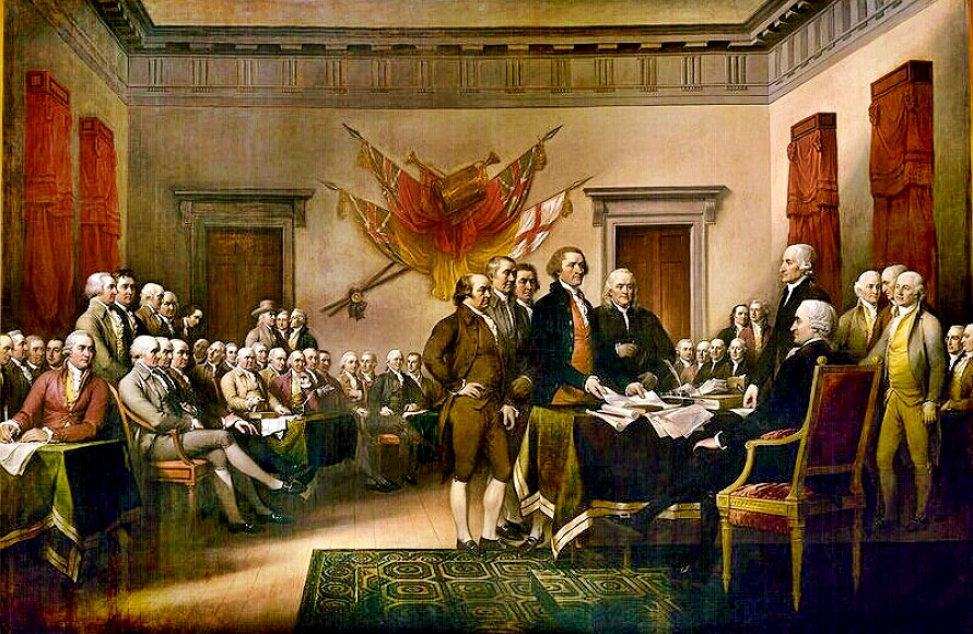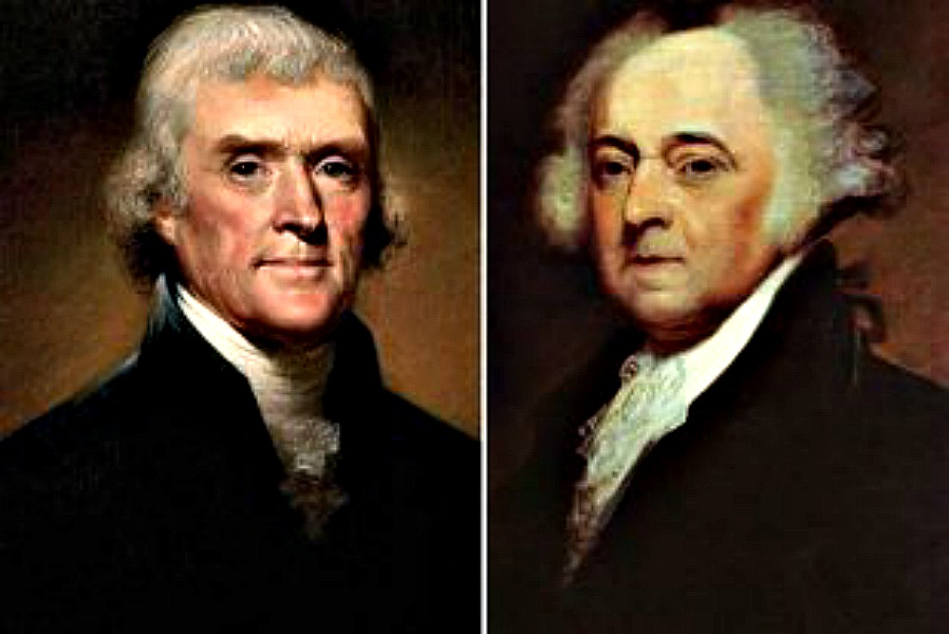On July 4, 1826, in Washington, D.C., the United States celebrated the 50th anniversary of the Declaration of Independence. On that same day, two of America’s revered founding fathers – men who had been dear friends, successive U.S. presidents and worthy adversaries for more than five decades – both passed away within five hours of each other. At the age of 90, John Adams died of heart failure in the late afternoon at his home in Quincy, Massachusetts. Just before he passed, Adams was said to have voiced three final words: “Thomas Jefferson survives.” Adams was not aware that only hours earlier, 500 miles away at his mountaintop Monticello estate in Virginia, the 83-year-old Jefferson had been the first to take his last breath.

To this day, that most theatrical sequence of events seems almost mythological. Certainly it was long known that Jefferson had a flair for the dramatic – one of the reasons John Adams had urged him back in June of 1776 to author the first draft of the Declaration of Independence. On the eve of the 50th anniversary of the signing, the historical significance of the occasion must have seemed obvious. But Jefferson left no doubt. On the night before his death, just before slipping into a coma, Jefferson whispered to his family: “Is it the Fourth?” He stayed alive until just past noon the following day.
As poetic as their passing was on that historic July 4th, it is the story of the two men’s complex and volatile relationship that has ever since imprinted a far deeper meaning on our country’s history. Adams and Jefferson met in Philadelphia in 1775 at the assembly of the Second Continental Congress. They worked side by side on the Committee of Five assigned to write the Declaration of Independence. Eight years later they served together as diplomats in Europe, deepening their friendship. During George Washington’s seminal U.S. presidency, Adams served as vice president and Jefferson as secretary of state. During Adams’s first and only presidential term from 1796-1800, Jefferson was his vice president. At the end of that term, Jefferson defeated his friend and rival for the presidency and went on to serve in that highest public office for eight years, while Adams exited the capital in 1800, retiring to his home in Quincy.

Even as Jefferson and Adams worked closely together and repeatedly expressed mutual affection and respect toward one another over the years, the two were also deeply divided on many occasions by sharp political differences. As one of the heads of the “Federalists,” Adams favored a strong central government, while Jefferson championed individual rights and a more limited national authority. As head of the “Democrat-Republicans,” Jefferson promoted the idea of the people being governed more directly through the power of state governments. A similar debate had taken place during the ratification of the Constitution in the late 1780s, as the Federalists and Anti-Federalists argued strenuously over what was to be the structural division of the new government authority. This philosophical clash may sound familiar, as more than two centuries hence the same arguments continue to play out in the nation’s political public square. In fact, the election contest of 1800 between Jefferson and Adams marked the establishment of formal political parties in the United States – the very concept that George Washington had warned against in his famous 1796 Farewell Address.
Beliefs about political philosophy, and by extension, the type of government system and rules that should emanate from those beliefs, consumed these men during what some have called “The Age of Passion.” Distinguished historian Joseph Ellis writes beautifully of “The Friendship” between Jefferson and Adams in his vivid book Founding Brothers. The raw politics were so rough in their head-to-head battle for the presidency in 1800 that after Jefferson’s triumph, not another word was written or spoken between the two for more than a decade.
Finally, in 1812, dialogue between the old friends was born again. Another signer of the Declaration, Dr. Benjamin Rush, had worked for three years to broker the resumption of communication. Upon hearing of the renewed exchange of letters, Rush wrote to Adams:
“I rejoice in the correspondence which has taken place between you and your old friend Mr. Jefferson. I consider you and him as the North and South poles of the American Revolution. Some talked, some wrote, some fought to promote and establish it, but you and Mr. Jefferson thought for us all.”
These few words from Rush conveyed a great truth. Fallible as they were, Jefferson and Adams fought and kicked and scratched and thought for the future of America for the better part of each of their lifetimes. Each in their own very different personal styles – Adams the feisty, hyperactive scrapper and Jefferson the model of reserve and restraint – battled directly with one another over firmly held beliefs, for love of their country.

Although the 14 years of written correspondence bonded the two men back into the deep friendship they had long enjoyed, it most certainly did not join their perspectives on the appropriate division of power between federal and state governments. They also differed in their outlook regarding what the American Revolution meant for the future of the nascent nation. Although both could not attend the Jubilee of Independence ceremony, each agreed to provide some words for posterity to be read on the 4th. The messages they sent would once again reveal the chasm between the two famous minds.
Of America’s founding, Jefferson wrote:
“May it be to the world, what I believe it will be, (to some parts sooner, to others later, but finally to all,) the signal of arousing men to burst the chains under which monkish ignorance and superstition had persuaded them to bind themselves, and to assume the blessings and security of self government.” Ellis eloquently breaks down the underlying intimation within what he calls “the vintage Jeffersonian vision”:
“It viewed the American Revolution as an explosion that dislodged America from England, from Europe, from the past itself, the opening shot in a global struggle for liberation from all forms of oppression that was destined to sweep around the world. In this formulation, all forms of authority not originating within the self were stigmatized and placed on the permanent defensive.”
Adams, ever the cautious leader, by contrast proclaimed that the United States was:
“destined in future history to form the brightest or blackest page, according to the use or the abuse of those political institutions by which they shall in time to come be shaped by the human mind.”
Adams warned future generations that the brand new rules system they had worked so hard to establish in the new government was by itself not enough. Future generations would need to harness the best thinking possible to promote the goals and ideals set out by the framers.
Still, although the two friends may have differed on the precise meaning of Independence Day and the historic form of American self-government they helped to create, they did agree on the fact that the new rules system was by no means perfect. Our nation’s founders were brilliant in many ways. But they were not divine seers. And they knew it.
This is exactly why provisions were included in our Constitution for changing the rules as circumstances demanded. Our system affords us a form of warranty recourse as citizen consumers of our government’s work product. Jefferson articulated this democratic right to peacefully alter the rules in 1787, a year before our Constitution was ratified, when he wrote:
“Happy for us, that when we find our constitutions defective and insufficient to secure the happiness of our people, we can assemble with all the coolness of philosophers, and set it to rights, while every other nation on earth must have recourse to arms to amend or restore their constitutions.”
And so on this 239th celebration of American Independence, let us remember the men and women of that historic Revolutionary Generation. Let us remember the extraordinary friendship between two of our nation’s founders that fatefully ended on the very day of the 50th celebration of the Declaration. And finally, let us remember this most important piece of the legacy they gifted to our country: the impregnable, constitutionally-guaranteed right, when we deem it necessary, to reform the rules in order to restore our system.
Happy 4th of July from Unlock Congress!
Best,
Michael


